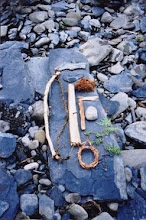Every so often, I will get questions by email that pertain to the Earth Skills Correspondence Course, and as I answer them, I think to myself 'I bet other students have questions similar to these, too.' So I thought I would share them so they are available to all of you out there who are into wilderness skills. Feel free to send me your own questions and I will answer them here when I get a chance.
From EW, from the Rochester, NY area (Now relocated to North Carolina):
Question 1: Weather - I'm having a heck of a time learning clouds - do you have any learning devices that help? I feel I'm just going by rote memory- read the book, look at the sky, and then try to memorize both for later reference - days pass and I'm looking at the sky unable to remember is that a 'this cloud' or a 'that cloud'?! Any thoughts on what to learn first and how?
Okay, this is a good question. It reminds me a lot of people first learning about trees, and how at first, they all look the same, so it is overwhelming. However, the key is to divide and conquer. (Just like learning your trees!) You want to start with the easy ones, the big ones, and learn those first. For example, Cirrus clouds are easy. They are wispy, thin clouds that are high in the atmosphere, made up mostly of ice crystals. They are also called Mare's Tails, because they look like the long tail hairs of horses. They appear at the uppermost edges of a new weather front, and often bring a change of weather.
.JPG) |
| Barry Keegan prepares a fire for our primitive pottery class, under a sky of Mare's Tails (Cirrus clouds). Autumn, 2007 |
 |
| Classic Cirrus clouds, or Mare's Tails, over the Hawk Circle Barn last summer... |
 |
| A bone harpoon with fluffy Cumulous clouds in the background. |
Weather is something that you can learn but it helps to do some journaling and see what happens after you start seeing different clouds. It is a practice in awareness, and it will aid your skills of tracking, survival and every other skill, because the details of the weather are part of every skill, and the weather changes all the time. But start slow and take your time with each aspect of understanding.
 |
| Cumulous clouds over the Tablelands at Gros Morne National Park, Newfoundland |
Question 2: This question was inspired by a post on one of your blogs - snow on a debris shelter in the winter - if you're confident in the shelters strength (good ribbing and ridge pole - lots of leaf matter, etc) -should the snow that falls on the shelter stay or be removed??
 |
| Musician and Wilderness Guy Sean Rowe digs through the snow to get to his shelter during a snow storm... |
One concern would be wet snow, which is very heavy and you could always take some of the snow off if you notice your ribbing or ridgepole getting pushed down or in.
The big concern with adding snow over your shelter is making sure you have some air holes and air flow in your shelter so you don't suffocate. You need to make sure your door opening has some space to let air in and out... Be sure to check it if you start getting some snow falling heavy that your doorway air hole is clear and open.
Does this make sense? Also, if you live in an area with lots of wet snow and freezing rain, the snow might keep your shelter from drying out when the weather gets warmer, so in that case, you might want to scrape off most of it as the weather changes.
Remember that your shelter should be built with strong sticks and brush, a good ridgepole that doesn't flex or has Y-stick supports under it, and about three feet thickness of leaves, ferns, grasses, pine needles or other natural material to insulate it from the elements. Built properly, you wouldn't even know it snowed outside if you were inside when the storm started...
Stay warm and dry and hope this answered your question.
Question 3: On cordage - do you have a good resource about the various plants used for cordage and when is a good time, better time and bad time to collect the plant material? Tree bark - good in the fall, okay in the summer? What about nettles? Or cattail leaves? It would be nice if the resource also noted what materials might be good for what projects- cattail (from what I've read) in not as strong as tree bark - How to process each plant would be great too! Too much to ask for from one book?!
 |
| Milkweed stalks found by the roadside, mid February, 2012 |
 |
| Dried milkweed stalks ready for storage! |
 |
| Soft, silky milkweed fibers, ready for twisting... |













2 comments:
In terms of a reference for fiber plants that tells when and how to use them, Arthur Haines' Book Ancestral Plants is great. It covers plants from the North East, but some of them grow elsewhere. It also cover a lot of other uses of a lot of plants. It is only available at http://www.anaskimin.org/support.html
If you want to know about pretty much every use for thousands of plants from across North America, Daniel Moerman's Native American Ethnobotany is perfect. It doesn't give instructions though.
Also search youtube, there are a lot of good fiber tutorials.
Thanks for the info, Nathan! I know that there are many good new books coming out all of the time, so it is good to get advice from as many people out there. Those sound good and I know it will help students.
Great comment and have a wonderful evening!
Post a Comment